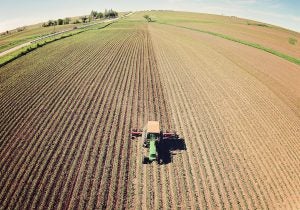A family farm is defined as a farm that is owned and operated by a majority of individuals directly related to the operator. Family farms have been the backbone of the United States’ economy since the nation was created so it should come as no surprise that 97 percent of all farms in the United States are family farms.
However, for many years, the number of farms in the U.S. has been in a steady decline. According to the USDA, the number of farms has fallen to 2 million today from 6.8 million in 1935. In 1900, around 39 percent of the population worked on a farm, and now only about 1 to 2 percent of the population is directly employed in agriculture.

So what’s causing farms to disappear?
Let’s consider the costs of starting your own farm from scratch. Economically, it is not feasible and often not even possible to start with a large enough investment to start your own farming operation. Even to start a small farm over 75 acres would require hundreds of thousands of dollars of investment, which most young people can simply not afford, let alone the yearly operating costs. For this reason, most smaller family operations will require a source of income from outside the farm to stay in business. By doing this, farmers can let the farm pay for itself while their living expenses come from an off-farm job.
Due to the high barrier of entry, fewer people are pursuing a career in farming and instead choosing to go to college to pursue other careers. Because of this, the average age of the American farmer has risen almost to age 60. This is causing concern among many about the future of farming as the average age of a farmer has been rising for 30 years and is still increasing.
According to the EPA, less than 25 percent of all farms in America have gross revenues over $50,000. This paints a dark picture when you consider that around 65 percent of all vegetable and dairy sales are produced by the 3 percent of very large family farms. Many smaller farmers with off-farm income choose not to expand since their incomes simply can’t support growth of their operations, and those who do may find it difficult allocating the time to spend enough of their off-hours working on the farm. Less capital for the smaller farmer means farms that are already large will find it easier to expand.
What does this tell us?
Average farm size has been increasing in recent years due to rising expenses requiring more sales to stay in business. Mid-size farms have been decreasing in numbers while there are more small farms now than ever. I relate this to a “breaking point” where farmers operating at the same size they always have are becoming slowly drowned out by competition from larger farms and rising expenses. When farmers fall below the point of where they can reasonably stay in business, they are either forced to find an off-farm job to reduce the drag of their living expenses on the farm, or sell the farm to the highest bidder. It is for this reason I believe farms 600 to 1,200 acres in size are disappearing — they are simply not producing enough to keep up with rising costs. This makes sense when you consider small family farms average only 231 acres in size with less than $250,000 in gross annual sales.
What effect does fewer farms have on non-farmers?
Farmland has hit record highs across America in recent years, causing many landowners to sell. A negative effect the increasing average farm size can have on rural communities is that there are fewer children attending rural schools, and less families supporting local grocery stores, restaurants, and other businesses. More families are forced to relocate to larger towns looking for work, which has a profound negative effect on small communities.
While larger farms are finding it easier to grow now, their larger size makes them more vulnerable to declining prices. Smaller and mid-size operations are better protected against this, as a single operator of a farm with fewer acres is better able to support their business with an off-farm job than a single operator of a large operation. We may continue to see mid-size farms disappearing until something drastic changes in the agriculture world, whether it be price swings or changing government anti-trust regulations.
We have been growing our family farm in recent years to fight this breaking point. Most farmers of today will find it critical to always be changing their methods and be ready to change, as there is no longer such a thing as a “dumb farmer” in today’s world.



